We need you! Join our contributor community and become a WikEM editor through our open and transparent promotion process.
Open book pelvic fracture
From WikEM
Contents
Background
- Results from an anteroposterior compression injury to the pelvis
- Often seen in elderly falls vs MVA or other high speed trauma
- Causes disruption of pubic symphysis and the pelvis opens like a book
- Results in tears of the strong pelvic ligaments that hold the pelvis bones together
- Large arteries pass near these ligaments and can get torn resulting in massive blood loss
Clinical Features
- pelvic/Hip pain
- Unstable pelvis
- hypotension if large amounts of bleed
- Consider concomitant GU injury
Differential Diagnosis
Abdominal Trauma
- Liver trauma
- Splenic trauma
- Pelvic fractures
- Acetabular pelvic fractures
- Open book pelvic fracture
- Straddle pelvic fracture
- Pelvic avulsion fracture
- Genitourinary trauma
- Retroperitoneal hemorrhage
- Renal trauma
- Ureter trauma
- Abdominal compartment syndrome
- Trauma in pregnancy
Evaluation
- Unstable pelvis on exam
- Xr pelvis in acute trauma setting
- CT Pelvis
Management
- Stabilize fracture with pelvic binder or bed sheet wrapped around greater trochanter (physician's often make mistake of wrapping around the iliac crest)
- If suspect pelvic injury and patient is unstable, place pelvic binder/sheet immediately then obtain X-ray when patient is stable
- If patient persistently hypotensive even after binder and suspect pelvic artery bleed consider IR for embolization
- Long term management requires orthopedic consultation
Complications
- Hypotension from exsanguination
- infection
- Loss of function
- Genitourinary injury
Disposition
Admission
See Also
References
Authors
Babak Missaghi, Ross Donaldson, Neil Young, Daniel Ostermayer

